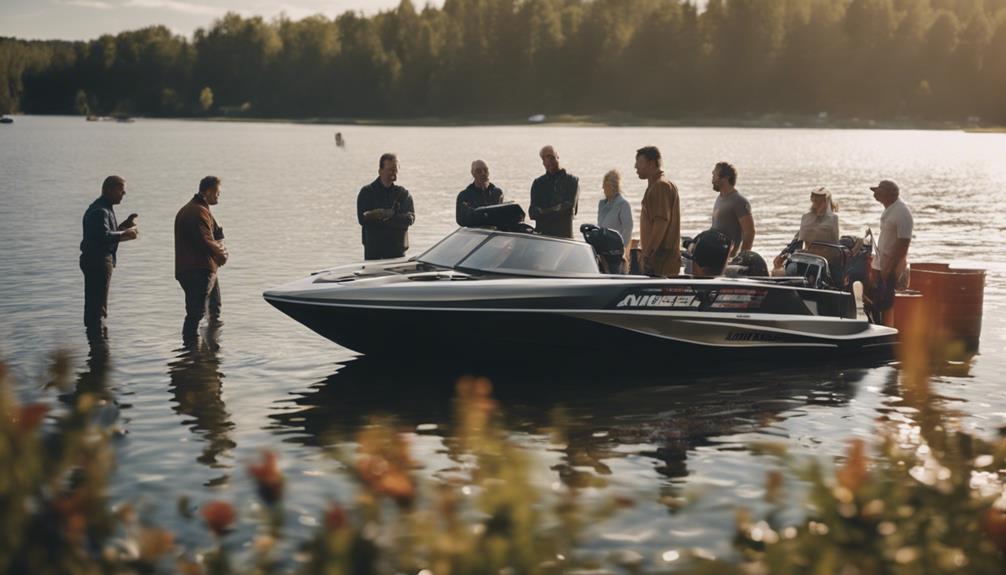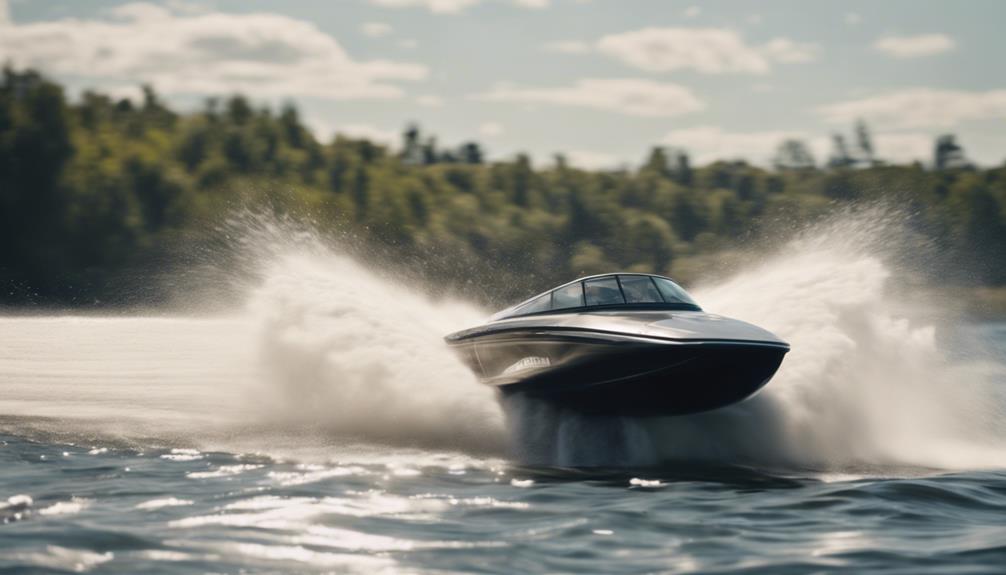Jet boats provide exciting speed and agility, perfect for thrilling water sports or steering through shallow waters. You'll love the impressive acceleration and minimal bow-rise, which enhances your visibility and handling. However, keep in mind that low-speed maneuvering can be tricky, especially for beginners. Also, be prepared for regular maintenance to avoid debris issues and engine noise. While they're not the most fuel-efficient option, jet boats excel in fun and versatility for fishing and family outings. If you're curious about more details on features and considerations, there's plenty more to explore.
Key Takeaways
- Pros: Jet boats offer quick acceleration and impressive maneuverability, enabling thrilling water experiences.
- Pros: Their shallow draft allows navigation in shallow waters, making them ideal for lakes and rivers.
- Cons: Inexperienced drivers may struggle with low-speed maneuvering due to smaller steering nozzles.
- Cons: Jet boats can ingest debris, potentially damaging the impeller and requiring regular maintenance.
Jet Boat Advantages
Jet boats come with several advantages that make them a popular choice for various water activities. One of the standout features is their jet drive, which allows for impressive acceleration and quick maneuverability.
With a shallow draft ranging from 12 to 17 inches, you can navigate through shallow water without worrying about grounding. This opens the door to exploring areas that other boats can't reach, enhancing your adventure.
The design of jet boats eliminates exposed rotating props, markedly reducing the risk of injury to swimmers and skiers in the water. You'll appreciate the safety this offers, especially during family outings.
Additionally, jet boats provide minimal bow-rise, improving visibility for you as the captain and making the overall driving experience more enjoyable.
Their superior handling and nimbleness give you that sportscar-like thrill on the water, appealing to those who crave excitement.
Whether you're fishing, enjoying a day out with family, or exploring shallow waters, the versatility of jet boats meets various needs.
Jet Boat Disadvantages

While jet boats offer thrilling performance, they come with notable disadvantages that can complicate your experience on the water.
One major issue is low-speed maneuvering. Many inexperienced drivers find it challenging to handle these boats, as the smaller steering nozzles can make tight turns difficult. This can lead to frustration when docking or reversing, especially since jet boat manufacturers often rely on less effective reverse gates compared to traditional propeller systems.
Additionally, performance variability is common among jet boats. You'll need practice to master their unique handling characteristics, which can be quite different from other boat types. Noise levels can also be a concern, particularly with older models and 2-stroke engines, resulting in a less comfortable experience on the water.
Moreover, jet boats are susceptible to debris ingestion, which can damage the impeller. This necessitates regular maintenance to remove foreign objects that may clog the jet system.
If you're considering a jet boat, be prepared for these challenges to guarantee you have a safe and enjoyable time on the water.
Usage Scenarios

For a variety of water activities, jet boats offer versatility that makes them a popular choice among recreational boaters. With their jet drives, these types of boats excel in shallow water exploration, allowing you to navigate lakes and rivers with ease. Whether you're out for a day of fishing, thrilling watersports, or a leisurely family outing, jet boats provide numerous advantages.
Here's a quick look at some usage scenarios:
| Usage Scenario | Key Features | Ideal For |
|---|---|---|
| Fishing | Shallow draft, spacious design | Fishing enthusiasts |
| Water Sports | Quick acceleration, agility | Thrill-seekers |
| Family Outings | Accommodates larger groups | Social gatherings |
You can enjoy the sporty performance of a jet boat while ensuring a safe and fun environment for everyone onboard. With models specifically designed for fishing, like the Yamaha 190 FSH, you can easily cater to your interests. The advantages of jet boats make them an excellent choice for various water activities, enhancing your overall experience on the water.
Maintenance Requirements

When you own a jet boat, keeping up with maintenance is essential for safe and efficient use.
You'll need to conduct regular inspections, stay on top of engine care, and monitor the hull for any damage.
Regular Inspections Needed
Regular inspections are essential to guarantee your jet boat operates safely and efficiently, so don't overlook these necessary maintenance tasks. One of the key components to check regularly is the impeller, which sucks up water and plays a significant role in your boat's performance. Confirm it's free of debris and functioning smoothly to avoid any performance issues on the water.
After each use, a thorough cleaning is necessary to prevent dirt and debris from clogging the jet system. This not only helps maintain optimal function but also prolongs the life of your jet boat. Additionally, you should inspect the hull for any scratches or damage that could lead to leaks or structural concerns.
Monitoring fuel levels and quality is also important; contaminants can greatly affect engine performance. While engine maintenance will be covered later, remember that regular inspections of oil levels and filters contribute to a healthy engine environment.
Engine Maintenance Importance
Maintaining your jet boat's engine is essential to guaranteeing it performs at its best and lasts for years to come.
Regular engine maintenance helps you avoid costly repairs and keeps your jet drive system running smoothly. High RPMs in jet boat engines can lead to increased wear, making adherence to maintenance schedules critical.
Here are some key tasks you should prioritize:
- Schedule routine checks at least twice a year.
- Clean the engine thoroughly after each use to remove debris and prevent clogs.
- Monitor fuel quality and levels to avoid engine performance issues.
- Inspect the impeller housed in the jet drive system regularly for wear and tear.
Hull Care Practices
To keep your jet boat performing at its best, you should prioritize routine hull care practices that prevent damage and enhance efficiency.
Start with regular hull inspections to spot any scratches or damages early. Addressing these issues promptly is crucial since they can affect your boat's water efficiency and overall performance.
After each use, make it a habit to clean the hull. This prevents marine growth and debris buildup, which can hinder your speed and fuel efficiency. A quick rinse or scrub can save you from bigger problems down the line.
Additionally, applying a protective wax or sealant is essential. This step enhances the hull's durability and boosts its resistance to UV damage and corrosion, ensuring it lasts longer against the elements.
Don't forget to check for signs of blistering or delamination, as these can compromise your hull's structural integrity.
Finally, seasonal maintenance, including thorough cleaning and inspections, is a must for the long-term performance and longevity of your jet boat.
Purchase Considerations

When considering a jet boat purchase, it's crucial to assess local water depth since their shallow draft lets you navigate in as little as 12 to 17 inches of water, helping you avoid grounding issues.
As a potential boat owner, you'll want to think about several factors before making your decision.
- Intended Use: Will you be using it for recreation, fishing, or water sports?
- Experience Level: Are you comfortable handling a jet boat, or do you need more practice?
- Budget: Consider not just the purchase price but also maintenance, insurance, and fuel consumption.
- Model Research: Compare specifications, performance, and features across brands to find the best fit.
Performance Factors

Jet boats excel in performance with their quick acceleration and agile handling, making them a thrilling choice for both leisure and adventure on the water.
One of the key performance factors is their impressive ability to reach planing speed rapidly, often with minimal bow-rise. This enhances your visibility as the captain, allowing you to navigate confidently.
Thanks to their innovative propulsion systems, jet boats have a shallow draft ranging from 12 to 17 inches, which lets you glide through just 3 inches of water at full throttle. High-speed models average speeds between 41 mph and 56 mph, providing an exhilarating experience for thrill-seekers.
However, you should be aware that jet boats are generally less fuel-efficient than sterndrives, consuming more fuel for similar horsepower, which can affect your operating costs.
Additionally, advanced handling features, like Yamaha's Advanced Responsive Handling suite, further enhance maneuverability, especially in tight spaces or low-speed situations.
Safety and Handling

With their impressive performance capabilities, jet boats also prioritize safety and handling, offering features that protect both passengers and those in the water. One of the standout safety features is the absence of exposed rotating propellers, which greatly reduces the risk of injury to swimmers and skiers nearby.
Additionally, their shallow draft allows you to operate in as little as 12 to 17 inches of water, making them perfect for traversing shallow lakes and rivers.
Here are some key aspects of safety and handling you should consider:
- Quick acceleration enhances responsiveness.
- Superior handling offers a sportscar-like driving experience.
- The reverse system uses a reverse gate to redirect water flow.
- Low-speed handling can be tricky, especially for those new to jet boats.
While jet boats provide excellent maneuverability, it's important to remember that the handling can differ greatly from traditional propeller-driven boats. As a result, you might need some time on the water to feel completely confident.
Market Insights

How are market trends shaping the future of jet boats in the boating industry?
Jet boats currently hold a small share of the market, representing less than 2% of total boat sales, but they're gaining traction. With only 4,800 units sold in 2017, it's clear there's potential for growth, especially among families and recreational users. This shift indicates a broader appeal beyond traditional boating enthusiasts.
The versatility of jet boats, suitable for activities like fishing, tubing, and social gatherings, makes them attractive to dayboaters and newcomers. You'll find they accommodate groups of 8 to 10 people, enhancing the experience for families looking to spend quality time on the water.
Quality and design play significant roles in influencing purchase decisions, as consumers seek unique experiences that set jet boats apart from conventional options.
As the marine industry evolves, focusing on these trends could lead to increased interest and sales in jet boats. If you're considering entering this market, now might be the right time, given the growing demand and the opportunity to cater to a diverse audience.
Embracing these insights could position you well for future success.
Owner Education

Understanding the fundamentals of jet boat mechanics and maintenance can significantly reduce costly repairs for owners. By investing in owner education, you'll not only enhance your boating experience but also prolong the lifespan of your vessel.
Here are some essential aspects to reflect on:
- Take boating courses to learn safe operation and handling of jet boats.
- Familiarize yourself with the owner's manual for critical operation and maintenance info.
- Engage in open communication with your dealer to clarify features and model choices.
- Prioritize learning about maintenance schedules to prevent mishaps.
Frequently Asked Questions
What Are the Downsides of Jet Boats?
Jet boats can be tricky to handle, especially at low speeds. You might find their noise level uncomfortable, and their higher costs could stretch your budget. Practice is essential to master their unique steering and performance.
What Are the Risks of Jet Boats?
Jet boats can pose significant risks, including high-pressure water streams that might injure you, difficulties steering at slow speeds, and challenges in rough waters. These factors can affect your safety and overall boating experience.
What Is Good About Jet Boats?
Jet boats are exciting because they accelerate quickly and handle superbly, giving you a thrilling ride. They can skim over shallow waters safely, and the open deck design lets you enjoy outings with friends comfortably.
How Long Do Jet Boat Engines Last?
Jet boat engines typically last between 1,500 to 2,500 hours with proper maintenance. You can extend their lifespan by performing regular inspections, oil changes, and ensuring proper winterization to protect against harsh conditions.
What are the safety features and potential risks of using a Jet Boat?
When it comes to jet boating safety, it’s important to understand the potential risks and how to mitigate them. Some safety features of jet boats include a sturdy hull design, safety lanyards, and emergency engine shut-off. However, it’s crucial to follow a comprehensive jet boating safety guide to ensure a safe and enjoyable experience on the water.
Conclusion
In the grand tapestry of watercraft, jet boats shine brightly, offering thrilling speed and nimble maneuverability.
Yet, like all gems, they come with their flaws—higher maintenance and limited shallow-water performance.
Weighing the pros and cons can guide your choice, ensuring you navigate toward the right vessel for your adventures.
Whether you're skimming across serene lakes or slicing through rivers, understanding these dynamics will help you chart a course to unforgettable experiences on the water.










